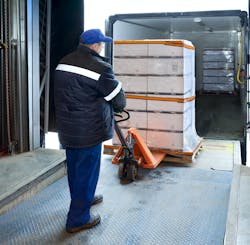Points to ponder as you prepare for the recovery
“Plans are worthless, but planning is everything.” – General Dwight D. Eisenhower.
Some of you must be wondering what kind of a bet I lost with the editor to have to write an economic outlook piece during these extremely unsettled times. After all, with so much change on the political, economic, and public health fronts, how can one make plans? The answer is in the quote above. Planning should be going on at all times.
Regular readers of this column will recall MacKay & Company has a proprietary measure of the trucking economy called truckable economic activity (TEA). If we start our planning exercises with a review of the current dynamic within each of its five major components, we can get both a reading on current conditions in the trucking economy and a strong sense of where the trucking economy is likely headed in the coming months.
We use the term “trucking economy” because while there is a close connection between the overall economy and the trucking economy, they are not the same entity.
The largest part of TEA is truckable consumption, accounting for about 43 percent of TEA in our most recent compilation of the numbers. This is also the least volatile of the components because it is tied to everyday activities associated with the movement of the goods we consume. We expect this component, which took a heavy hit during the pandemic shutdown, to continue to rebound from that hit. The major constraint on this variable will be consumers’ ability to get out and spend, meaning the pace of vaccinations will be key.
The next largest part of TEA covers business capital spending and all forms of construction. We call this truckable investment, which is currently about 23 percent of total TEA. Activity here over the course of 2021 will be driven by profits and profit expectations, and it is here that most of the elements of uncertainty we mentioned at the outset will come into play. These factors will add to the already volatile nature of this type of spending. You can expect about as much bad news as good news over the next year.
Elements three and four on our list are exports and imports. Exports accounted for 13 percent of total TEA in the last tally, while imports came in at 11 percent. Before we go on to discuss those elements, it should be noted that the sum of truckable investment, truckable exports, and truckable imports accounts for almost half of total TEA. This is a far larger share of activity than these sectors represent in gross domestic product, and it is the basis for our earlier statement that the trucking economy and the general economy are not the same entity.
For both truckable exports and truckable imports, the major issue will be the supply chain – the physical ability to move goods to and from ports. A secondary element will be how often ships arrive and leave from those ports, as well as the availability of containers along the entire length of the supply chain. Tariff issues are still in play, but their role will be far less important in the immediate future.
The last component of TEA is truckable government, representing about 8 percent of the total. The largest element of this measure is state and local government spending on structures. We think budgets are going to be constrained as the full effects of the pandemic on state and local revenues have still to be calculated.
Lastly, do not confuse a rebound with a recovery. So far, we have rebounded, but we have not yet recovered. Plan for recovery.
MacKay & Company specializes in market research for commercial trucking, construction equipment, and agricultural machinery. The company provides strategic research and analysis to vehicle and component manufacturers, distribution and service channels, industry associations, and private equity firms. With a long career managing portfolios and coordinating domestic economic forecasting programs, Dieli began RDLB, Inc. in 2001. In this role, Dieli serves as an advisor to many firms in the trucking, consulting, and financial services sectors. He is also an economist with MacKay & Company.
About the Author

Robert Dieli
Economist at MacKay & Company
MacKay & Company specializes in market research for commercial trucking, construction equipment, and agricultural machinery. The company provides strategic research and analysis to vehicle and component manufacturers, distribution and service channels, industry associations, and private equity firms. With a long career managing portfolios and coordinating domestic economic forecasting programs, Dieli began RDLB, Inc. in 2001. In this role, Dieli serves as an advisor to many firms in the trucking, consulting, and financial services sectors. He is also an economist with MacKay & Company.
